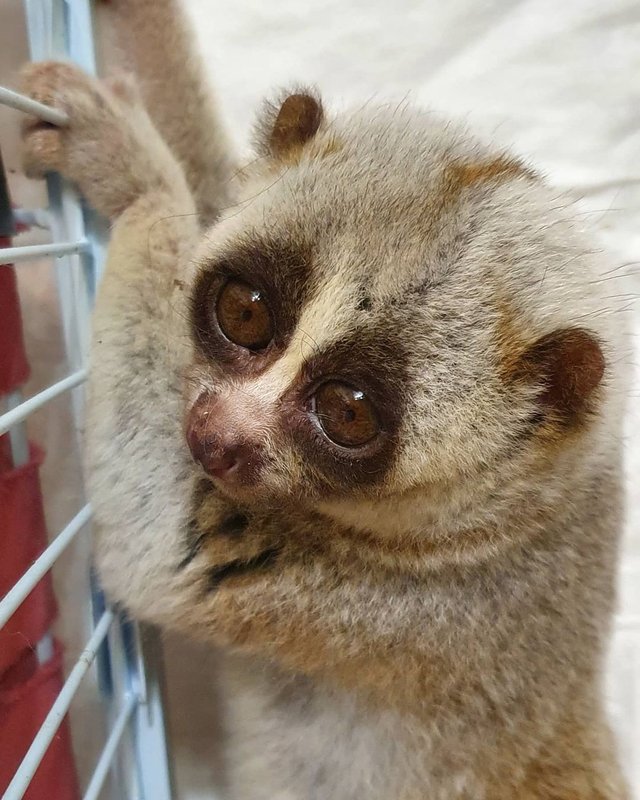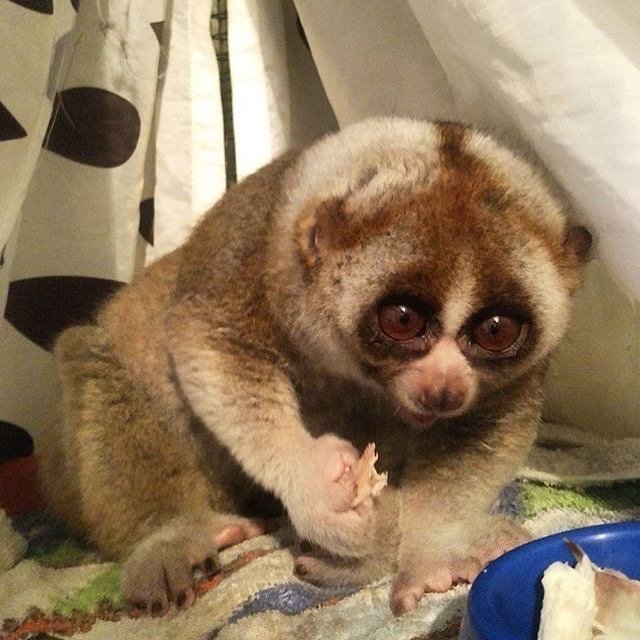Slow loris are cute primates known for their shyness. Weighing between 20 and 30 centimeters, the nature of this animal is truly shy and will'annoy' those who see it.

Another thing that makes us curious about slow lorises is the slow motion. This can be seen how he walks naturally when he is crouching around a tree branch and when he chews food too slowly.

It's a shy and comfortable style, but it's not always possible to see lemurs. The reason is that slow lorises are nocturnal animals that are active at night. So he will sleep well at dawn and wake up at dusk. It's a night for slow lorises to find food or play around.
However, be careful when seeing slow rose blooms at night. Slow Loris will not be very disturbed by bright rays. Slow loris eyes correspond to about 5 watts or a light sleeper.
Are you interested in the characteristics of Slow Loris? Here's a summary of 7 unique facts about slow lorises from various sources.
1. There are three types of slow lorises in Indonesia.
There are three types of slow lorises in Indonesia, depending on their ecology and distribution: the Javan slow loris (Nycticebus javanicus), the Sumatran slow loris (Nycticebus coucang), and the Kalimantan slow loris (Nycticebus menagensis).
There are two ways that can be done to distinguish the three types. First, the weight. The Javan slow loris weighs about 900 g, the Sumatran slow loris weighs about 700 g, and the Kalimantan slow loris weighs about 600 g.
Second, according to its characteristics. The Javan slow loris has bright bumps that are more beautiful than the Sumatran and Kalimantan slow lorises, which are grayish brown in color.
According to data from the International Union for Conservation of Nature (IUCN), the Javan slow loris is classified as critical endangered (CR) or a step towards extinction in nature. Meanwhile, the Sumatran slow loris and the Kalimantan slow loris are three steps towards being vulnerable or extinct.
2. Laziness is smart
The slow loris is a smart animal. This can be seen from the way he eats only the flesh of the fruit. While the skin and seeds are removed. In addition, the fruit that the lemurs like is really ripe and of course, sweet on the tongue. So, don't expect the slow loris to turn sour and eat the raw fruit.
3. His body is flexible
Slow lorises have flexible bodies. He can twist on tree branches and even hang upside down. While sleeping, the slow loris lowers its head and rolls its body like a kneeling ball. This rolling position protects it from hiding enemies during sleep. As a result, the slow loris sleeps on a very safe branch of a large tree.
4. The slow loris is not a mentus.
Slow lorises, although they are different from one another, are often considered the same as cuscus. The slow loris has a round face shape, and the tip of the slow loris leaves tapers forward with the tip of the nose. The cuscus is a marsupial, but not a slow loris. In addition, the hands and fingers of the slow loris are longer than the kercus. Because the slow loris is an animal that spends its life in trees (trees). While the cuscus has a long and strong tail which functions as a hanging tool when moving from one branch to another.
5. Loris' fangs are poisonous.
Slow lorises are primates that produce poison that can be used to defend against predators or when at risk. Sloth bites are actually harmless because the poison doesn't come out of their fangs. Loris venom is produced by the glands located in the inner elbow, then inserted into the mouth and mixed with saliva before Loris bites.
Loris bites can lead to serious allergies that can cause redness of the skin and symptoms such as itching, muscle cramps, fever, and fainting.
6. In search of myths
The slow loris hunt continues. This is because there are social myths that sacrifice slow loris for the construction of roads or bridges. The reason is that the road or bridge is durable and not easily damaged.
In fact, slow lorises are animals protected under No. 5 of the 1990 Act on the conservation of living natural resources and ecosystems. Slow lorises are prohibited from being exploited, such as hunting, caring, trading, or being used for body parts. Storage of slow rose flowers is subject to imprisonment of up to 5 years and a fine of 100 million rupiah.
Slow Loris must be loved. Because in nature, slow lorises are part of the ecosystem that sucks flower nectar, eats insects and fruits, and maintains the balance of nature. Hunting slow lorises is like disturbing the balance of well-organized and tidy natural ecosystems.
7. Not a pet
Studies conducted by Nafisatul Ulfa and Mirzan Adi Wibowo of the Department of Veterinary Medicine at Bogor Agricultural University of the Indonesian International Animal Rescue Foundation (YIARI) have the potential for animal disease, a disease that can be transmitted from animals to humans and vice versa. Slow lorises. One of the diseases that can be transmitted to humans is worms.
This large number of worms were found in the results of stool (stool) tests of slow lorises. The worms found were genus of nematodes (gilik worms) and cestodes (flatworms). Insect transmission from animals to humans can occur through eggs ingested or inhaled by humans. Or through direct contact or through eggs, fruits, water and clothing in the ground.
These insect eggs can live from 2 months to 2 years in an environment conducive to humidity, climate and temperature.
Allowing slow lorises to live in the wild is a smart way to preserve slow lorises in nature.